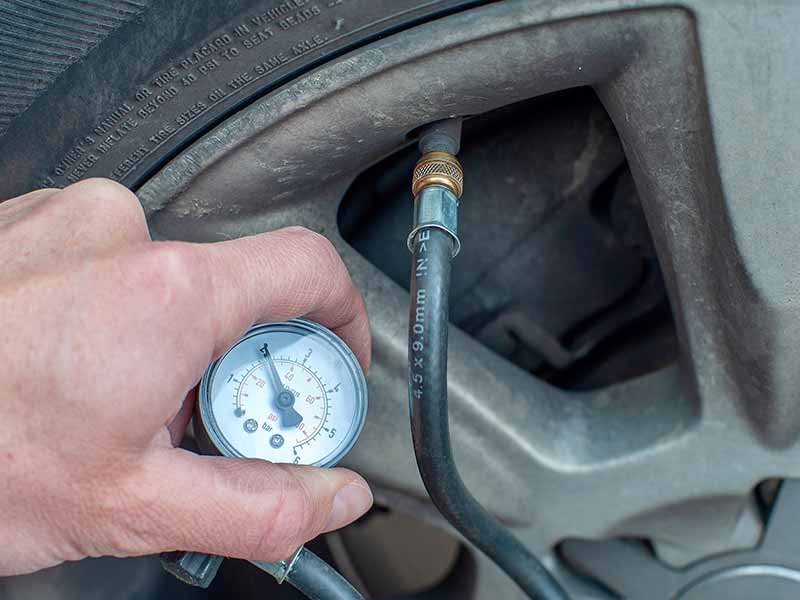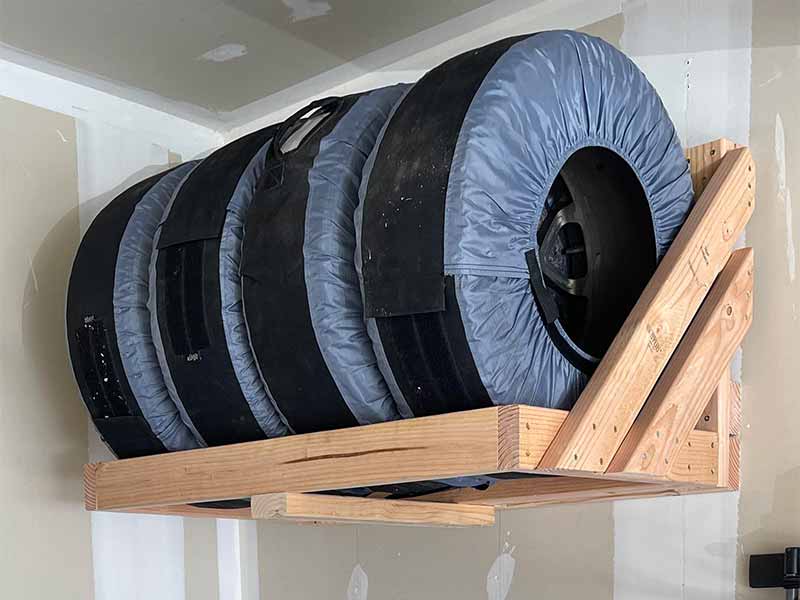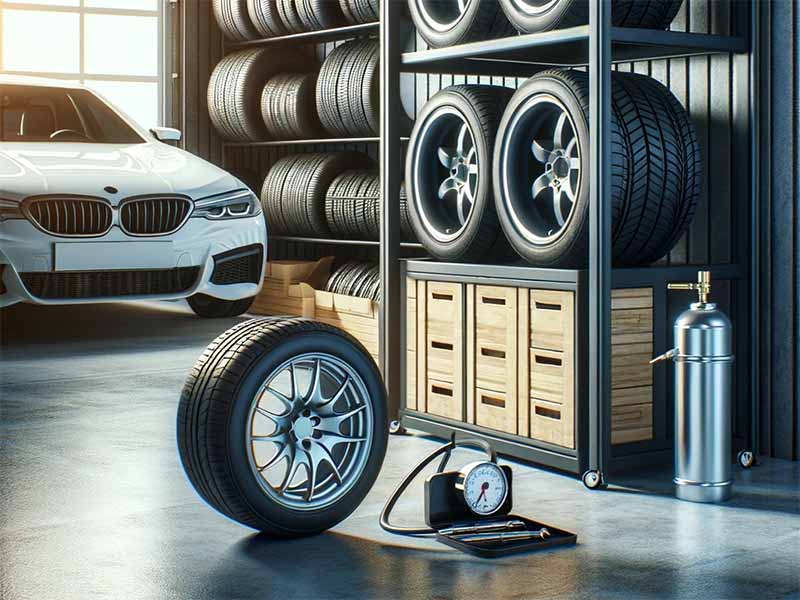Are you planning to store your vehicle or swap out seasonal tires? Knowing the right tire pressure for storage isn’t just a small detail—it’s crucial for maintaining your vehicle’s performance and extending the life of your tires.
What Pressure To Store Tires?
When storing tires still mounted on a vehicle, inflate them to slightly above the recommended pressure to counteract the vehicle weight.
When storing tires separately, inflate to the normal operating pressure to maintain shape without the weight of the vehicle bearing down.
In this article, we explore why maintaining the correct tire pressure is essential during storage, how to properly adjust tire pressure for different storage scenarios, and best practices for protecting your tires from environmental factors like UV rays, ozone, and temperature fluctuations.

Is Tire Pressure Important During Storage?
When it comes to storing your vehicle, whether for a season or longer, the importance of maintaining the correct tire pressure cannot be overstated. Tire pressure plays a crucial role in preserving the condition and longevity of your tires even when they are not in use. Here’s why tire pressure is so important during storage:
Preventing Flat Spots
- Uneven Pressure Distribution: When a tire is underinflated, the weight of the vehicle isn’t evenly distributed across the tire’s surface. This can lead to flat spots, where parts of the tire become flattened due to prolonged pressure.
- Long-Term Damage: These flat spots can cause permanent damage to the tire, leading to a need for premature replacement and potentially unsafe driving conditions when the vehicle is used again.
Avoiding Sidewall Cracking
- Underinflation Risks: Underinflated tires can cause excessive flexing of the sidewalls. Over time, this can lead to cracks and splits, weakening the tire’s structure.
- Preserving Tire Integrity: Properly inflated tires maintain their shape and reduce the risk of sidewall degradation, thus preserving the tire’s integrity.
Maintaining Tire Shape
- Shape Retention: Correct tire pressure helps tires retain their shape and structure. This is especially important for tires that are not being rotated or moved for extended periods.
- Reduced Deformation Risk: Tires at the right pressure are less likely to deform or warp, ensuring they perform optimally when put back into use.
Safety and Cost-Effectiveness
- Safety Assurance: Properly stored tires with correct pressure ensure that when you drive your vehicle again, the tires are safe and reliable.
- Economic Benefits: Maintaining tire pressure can prevent costly repairs or replacements due to storage-related damage.

Adjusting Tire Pressure for Storage
Properly adjusting tire pressure is crucial for tire longevity and performance, whether you’re storing tires on a parked vehicle or separately, such as when switching between summer and winter sets. Each scenario has its nuances, and understanding how to care for your tires in each situation is essential. Here’s how to adjust tire pressure for different storage situations:
Storing Tires on a Parked Vehicle
- Slightly Higher Pressure: Inflate tires to a slightly higher pressure than what’s used for regular driving. This counters the gradual loss of air and helps prevent flat spots.
- Regular Checks: Even when not in use, check the tire pressure periodically to ensure it remains within the recommended range.
- Use Jack Stands: If possible, use jack stands to take the weight off the tires and prevent flat spots from forming during long-term storage.
- Rotate Tires: If storage extends for several months, consider rotating the tires to distribute any weight or stress evenly.
Storing Tires Separately from the Vehicle
- Clean and Inspect: Before storing, clean the tires of any dirt or debris and inspect them for damage. Make sure they are dry to prevent mildew or deterioration.
- Inflate to Normal Pressure: Inflate the tires to their normal operating pressure, as they won’t be bearing the weight of the vehicle and won’t need the extra inflation.
- Proper Positioning: Store tires in a vertical position, and if they’re mounted on rims, you can also hang them. Avoid stacking unmounted tires flat to prevent distortion.
FINDING THE NORMAL OR RECOMMENDED TIRE PRESSURE
Before you can adjust the tire pressure for storage, it’s essential to know the normal or recommended tire pressure for your specific car or truck.
- Vehicle Owner’s Manual: The most reliable source for finding the recommended tire pressure is your vehicle’s owner’s manual. It will provide the manufacturer’s recommended PSI (pounds per square inch) for the front and rear tires.
- Tire Information Placard: Look for a tire information placard located on the driver’s side door edge, doorpost, glove box, or fuel door. It lists the proper tire size and inflation pressures for your vehicle.
- Tire Sidewall: The sidewall of your tire won’t provide the recommended pressure, but it will list the maximum pressure. Remember, this is not the pressure you should typically inflate your tires to; it’s the upper limit.
- Manufacturer’s Website or Customer Service: If you don’t have access to the owner’s manual, check the manufacturer’s website or contact their customer service for information about your specific model.

Options for Storing Tires Off of a Vehicle
When storing tires off of a vehicle, such as seasonal tires or spare sets, it’s crucial to choose the right storage method to preserve their shape, structure, and integrity. Whether you’re hanging or stacking the tires, the way you store them can significantly impact their longevity and performance. Here are some options and insights into whether stacking or hanging is preferred and if vertical or horizontal stacking is better for tire storage:
Stacking Tires
- Horizontal Stacking: If you’re storing tires without rims, you can stack them horizontally one on top of the other. However, it’s important not to stack them too high to prevent the bottom tires from deforming under the weight.
- Vertical Stacking: For tires mounted on rims, vertical stacking (standing them upright) is preferable. It prevents the tires from deforming under their own weight and maintains their shape better than horizontal stacking.
Vertical vs. Horizontal Stacking
- Preferred Method: Generally, vertical stacking is preferred, especially for tires on rims, as it puts less stress on the tires and maintains their shape. Horizontal stacking can be used for short-term storage or if space constraints require it, but ensure not to stack too many to avoid deformation.
Hanging Tires
- Ideal for Tires with Rims: Hanging is a great option for tires that are mounted on rims. Use hooks or racks specifically designed for tire storage to avoid distortion.
- Spacing: Ensure that tires are not touching each other or the wall to promote air circulation and prevent any potential flat spots or sidewall damage.
Stacking vs. Hanging
- Preferred Method: If you have the means, hanging is often preferred over stacking, especially for tires mounted on rims. Hanging eliminates the risk of the tires deforming under their own weight or the weight of other tires. It’s ideal for long-term storage and maintains the shape and condition of the tire exceptionally well.
- Considerations for Stacking: If hanging is not an option, then vertical stacking is the next best choice for tires on rims. For tires without rims, horizontal stacking can be used, but with caution to not stack too high and to rotate them periodically.

Tire Covers
Best Practices for Protecting Tires During Storage
Proper tire storage is not just about where or how you place the tires; it’s also about protecting them from various elements that can cause deterioration. UV rays, ozone, and temperature fluctuations are among the primary concerns when storing tires. Here’s how to ensure your tires are well-protected and remain in good condition throughout their storage period:
Protection from UV Rays
- Covering Tires: Use tire covers or bags specifically designed for tire storage. These covers will block out sunlight and UV rays that can cause the rubber to deteriorate and age prematurely.
- Indoor Storage: Whenever possible, store tires indoors away from windows or areas where sunlight can directly hit the tires.
- Choosing the Right Location: If indoor storage isn’t an option, choose a shaded area or cover the tires with a tarp that provides UV protection.
Guarding Against Ozone
- Avoid Ozone Sources: Keep tires away from equipment that generates ozone, such as motors, generators, furnaces, or any electrical equipment that can produce sparks or emit ozone.
- Proper Ventilation: Ensure the storage area is well-ventilated to dissipate any ozone that may be present and to avoid any buildup of harmful gases.
Managing Temperature Fluctuations
- Climate Control: The best scenario for tire storage is a climate-controlled environment where temperature fluctuations are minimal. Consistent, moderate temperatures will help maintain tire integrity.
- Avoiding Extreme Temperatures: Avoid storing tires in locations where temperatures can become excessively hot or cold. Garages or sheds that are not insulated can experience extreme temperature changes that are harmful to tires.
- Insulation: If you can’t control the climate, consider insulating the storage area or at least providing some barrier to extreme temperatures, such as storing the tires off the ground and away from exterior walls.
General Best Practices
- Regular Inspections: Periodically inspect stored tires for any signs of damage or changes, such as cracks or pressure loss.
- Clean Before Storing: Remove any dirt, grease, or debris from the tires. Ensure they are dry before covering or stacking them to prevent mildew or water damage.
- Avoid Contact with Certain Materials: Keep tires away from solvents, fuels, lubricants, or any chemical substances that can degrade rubber.
Resources
Below are some links you may find helpful when learning about tires:
- How to store tires to prevent dry rotting and extend their life – Life Storage
- Tire storage tips – Goodyear
Final Thoughts
Maintaining the correct tire pressure during storage is crucial for the health and longevity of your tires. It prevents flat spots, sidewall cracking, and maintains the tire shape, ensuring safety and performance when you’re back on the road.
Whether you choose to stack, hang, or vertically store your tires, doing so in a cool, dry, and dark place while protecting them from UV rays, ozone, and extreme temperatures will preserve their condition. Regular inspections and adjustments are key to avoiding costly repairs or replacements due to storage-related damage.
Good luck and happy motoring.





